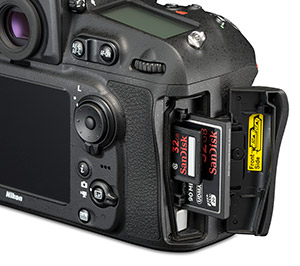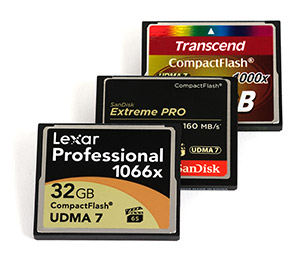 Camera Memory Speed
Camera Memory SpeedMemory Card Comparison & Performance Tests for Digital Cameras

Nikon D810 Fastest CF and SD Memory Cards
Published: September 1, 2014
Which CF and SD cards are fastest in the Nikon D810? We test several CompactFlash and Secure Digital cards and recommend which card to choose when speed matters.
The D810 can shoot faster than the D800 (5fps vs 4fps). Nikon also boosted processing performance with the new EXPEED 4 processor. Our tests show the new D810 can write faster as well. Both CF and SD card write speeds are significantly improved over the D800. Our fastest CF card reaches 98.6MB/s write (compared with 71.1MB/s for the same card in the D800); the fastest SD card now reaches over 71.8MB/s write performance (compared with 38.7MB/s in the D800). This is still far from allowing infinite continuous shooting in RAW, but it makes a noticeable improvement in the overall speed of the camera.
D810 Memory Card Test– Write Speed
Test date: August 5, 2014
We begin by filling each card with images. This assures the starting point is consistent and approximates actual use. Next we format the card in the D810. The camera is set to manual mode and aimed at a test scene (the same scene used in the D800 test). We take 15 frames in Continuous High of 14-bit uncompressed RAW images. The resulting images are 75MB .NEF format. We time each test beginning when the card light illuminates to when it goes out. We then divide the total bytes written by the time in seconds to achieve the write speed (MB/s) using 1 MB = 1,048,576 bytes. We repeat this procedure 10 times for each card and average the results.
| Memory Card | Card Type | Average Write Speed (MB/s) | Price |
|---|---|---|---|
| Lexar Professional 1066x 32GB | CF | ||
| SanDisk Extreme Pro 160MB/s 32GB | CF | ||
| Transcend 1000x 32GB | CF | ||
| SanDisk Extreme Pro 95MB/s 32GB | SD | ||
| Toshiba Exceria Type 1 32GB | SD | ||
| Samsung PRO 32GB | SD | ||
| SanDisk Extreme 120MB/s 32GB | CF | ||
| Toshiba Exceria Type 2 32GB | SD | ||
| SanDisk Extreme Plus 80MB/s 32GB | SD | ||
| Sony 94MB/s 32GB | SD | ||
| Lexar Professional 800x 32GB | CF | ||
| SanDisk Extreme 45MB/s 32GB | SD | ||
| Kingston Ultimate 32GB | SD | ||
| Lexar Professional 600x 32GB | SD | ||
| Lexar Professional 400x 32GB | SD | ||
| SanDisk Ultra 50MB/s 32GB | CF | ||
| Transcend 600x 32GB | SD | ||
| Samsung EVO 32GB | SD | ||
| Kingston Ultimate 600x 32GB | CF | Card Error |
D810 Memory Card Test– Continuous Shooting
The Nikon D810 continuous shooting test measures how many images can be taken in 30 seconds. This test was done using three different image formats: RAW+JPEG, RAW, and JPEG. The number of images depends on both the scene and camera settings. The test does not seek to find the maximum number of images possible, but compares the difference between memory cards.
Settings:
RAW: 14-bit Lossless Uncompressed.
JPEG: Fine, Large, Optimal Quality.
| Memory Card | Card Type | Continuous Shooting – Images in 30 Seconds | Lowest Price | ||
|---|---|---|---|---|---|
| RAW+JPEG | RAW | JPEG | |||
| Lexar Professional 1066x 32GB | CF | ||||
| SanDisk Extreme Pro 160MB/s 32GB | CF | ||||
| Transcend 1000x 32GB | CF | ||||
| SanDisk Extreme Pro 95MB/s 32GB | SD | ||||
| Toshiba Exceria Type 1 32GB | SD | ||||
| Samsung PRO 32GB | SD | ||||
| SanDisk Extreme 120MB/s 32GB | CF | ||||
| Toshiba Exceria Type 2 32GB | SD | ||||
| Sony 94MB/s 32GB | SD | ||||
| SanDisk Extreme Plus 80MB/s 32GB | SD | ||||
| Lexar Professional 800x 32GB | CF | ||||
| Kingston Ultimate 32GB | SD | ||||
| Lexar Professional 600x 32GB | SD | ||||
| SanDisk Extreme 45MB/s 32GB | SD | ||||
| Lexar Professional 400x 32GB | SD | ||||
| SanDisk Ultra 50MB/s 32GB | CF | ||||
| Transcend 600x 32GB | SD | ||||
| Samsung EVO 32GB | SD | ||||
| Kingston Ultimate 600x 32GB | CF | Card Error | |||
Recommended Nikon D810 Memory Cards
 For outright speed, the D810 shooter should use one of the 3 fastest CompactFlash cards: Lexar Professional 1066x, SanDisk Extreme Pro and Transcend 1000x . These CompactFlash cards allow the D810 to perform at its full potential.
For outright speed, the D810 shooter should use one of the 3 fastest CompactFlash cards: Lexar Professional 1066x, SanDisk Extreme Pro and Transcend 1000x . These CompactFlash cards allow the D810 to perform at its full potential.
The next step down are three of the fastest Secure Digital cards: SanDisk Extreme Pro UHS-1 95MB/s, Toshiba Exceria Type 1 and the Samsung PRO. These offer good performance at a lower price. The Samsung PRO is the value leader for the D810, offering good speed at a low price point.
The Kingston Ultimate 600x 32GB CompactFlash card did not work in the D810. The camera displayed "Card Err" on the top LCD and the following message appeared on the rear monitor: "Cannot format memory card. Card may be defective. Insert another card."
Transferring Images from Camera to Computer
We tested download speed using the USB 3.0 connection on the D810 to see how fast it could transfer images to the computer. We discovered the D810 behaved similarly to the D800 in that it was limited in its throughput. We transferred 4GB of RAW images from the D810 to the computer. Transfers using CF cards averaged between 50-60MB/s. Occasionally we would see a transfer up to 65MB/s but no card averaged above 60MB/s over multiple tests. SD cards were even slower, the fastest SD cards would only transfer up to 45MB/s using the USB cable. These results are much slower than using a separate dedicated card reader. Using the fastest CF cards we could transfer up to 140MB/s directly from the card. In a card reader SD cards would transfer above 90MB/s. See our Card Reader Reviews for more details.
Testing Procedure Background Information
You may wonder why we use images to fill the card rather than a full overwrite format (zero fill or secure erase). We have tested different formatting methods and a few cards show a slight improvement in write speed and consistency after a zero-fill format. However, this is not how a photographer normally uses a memory card. A full overwrite is time consuming and flash media has a limited life span in write cycles. Actual image files are essentially random data and represent a card that has been previously used. The card is subsequently formatted in camera which wipes the file allocation table but not the underlying data.
The same testing procedure is used on the Nikon D800 memory card speed tests to allow a direct comparison between the two cameras. The 15 frames were chosen as a base point on the D800 because that is roughly the number of images to fill buffer after which it slows down the frame rate. The D810 can continue a few more frames before it slows down (approximately 19-20).